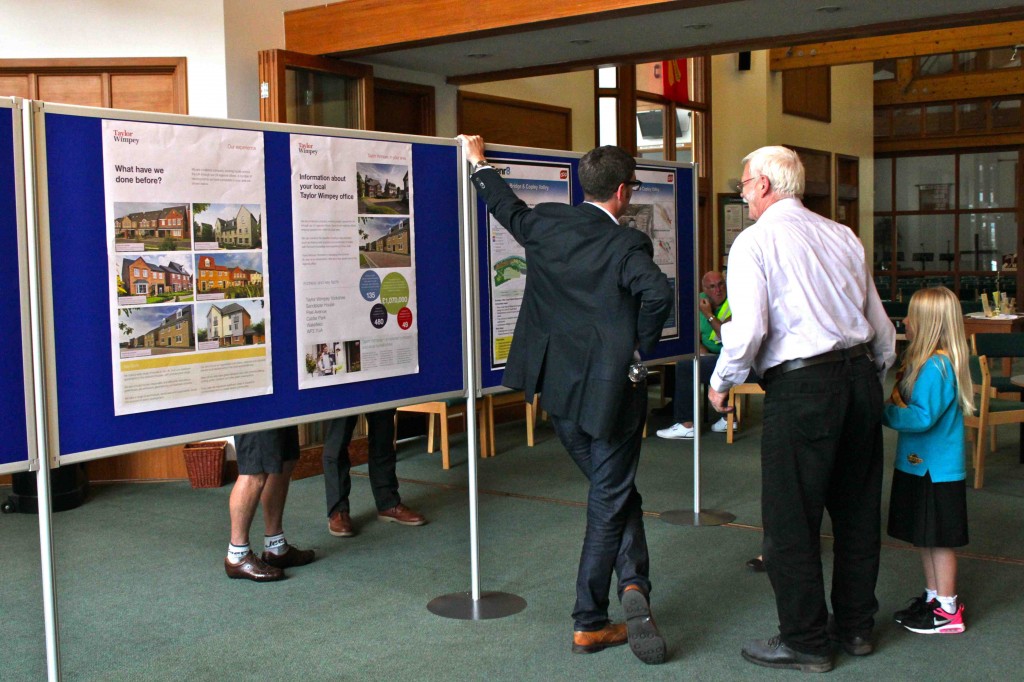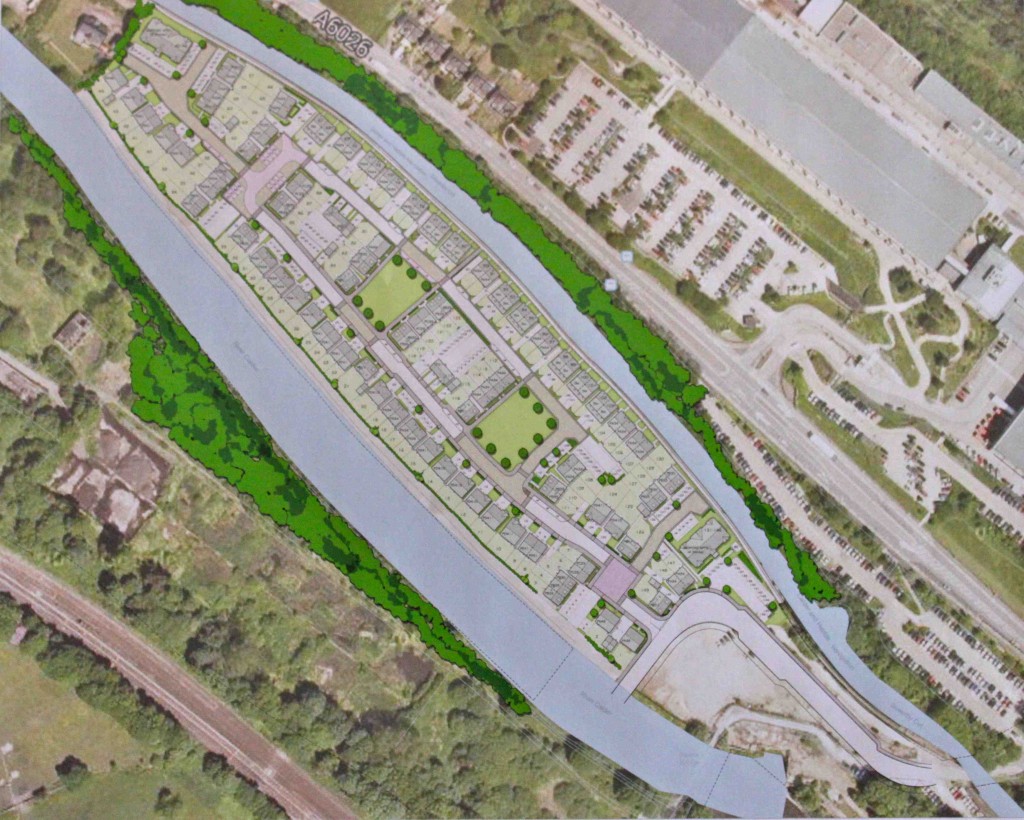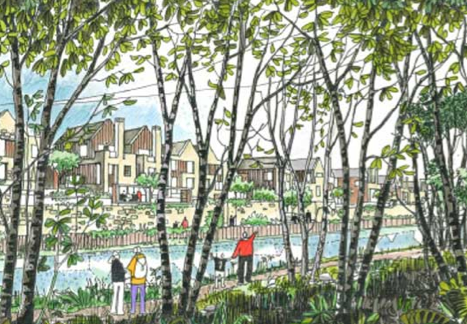The Taylor Wimpey exhibition of plans for 149 new houses in Copley Valley was open to the public for one day last week.
This was to allow the public to see the plans that will make up the detailed planning application for the housing development, that was due to go to Calderdale Council on Monday 8th September.
But the detailed planning application doesn’t yet seem to be on the Calderdale Council planning portal.
The centrepiece of the exhibition was the plan for 149 new houses on the 2.4ha island between the River Calder and the canal.
This is just part of the contentious Sowerby Bridge Copley Valley (SBCV) Regeneration Project.
No “affordable” housing
A representative of the architects company that designed the layout of the housing told me that because of the costs of decontaminating the site and making it flood proof, there will be no “affordable” housing on the site.
But in reply to a Freedom of Information request, Calderdale Council has confirmed that the developer GenR8 has received £6.182m of public money from Yorkshire Forward to cover the costs of:
“site clearance, decontamination works, site investigation works and highway/junction improvement works that have been undertaken on site.”
This doesn’t mention the costs of flood-proofing the site. These are considerable since the site is a flood plain.
Plain Speaker is trying to find out if GenR8 is paying for the flood-proofing work, or if this too is coming out of public funding.
Perhaps this question will be clarified in the detailed planning application?
High density housing
I asked the representative of the architects company about the housing density, but she wasn’t sure.
But according to an Inside Housing article, the average housing density in the UK is 42 dwellings/ha, and new housing in England is built at an average of 25 dwellings/ha.
So the SBCV housing estate is much higher density than the average.
149 houses on 2.4ha equals 62 houses/ha. – more than twice the density of average new housing developments.
A study by the Commission for Architecture and the Built Environment found that public concerns about high density developments include:
- the effect on local services, traffic and parking
- fears that they would be out of keeping with the local area
- lack of public spaces and play areas
These were certainly among the concerns expressed by members of the public at the exhibition.
Air pollution worries
One Sowerby Bridge resident said he was worried about the increased air pollution that would result from extra cars from the 149 new households driving along Wakefield Road.
He pointed out that the site is between two Air Quality Management Areas – pollution hotspots where air pollution levels from traffic exceed safe levels.
He said that, as a runner, he’d stopped running along Wakefield Road because the air pollution was already so bad. And he was worried that GenR8’s plans to cut down swathes of trees that currently cover much of the site would make pollution worse.
Schools
He also questioned how local schools would cope with extra children from the new housing estate, since both local schools are already full.
Sowerby Bridge Councillor Dot Foster said,
“We are asking that the developers bear in mind the lack of school provision at local schools, and work with us to come to a solution. We have mentioned that the local school provision also needs to include looking at High Schools, as Ryburn was also over-subscribed this year. We have requested a report from Taylor Wimpey on how many children are likely to inhabit the housing development and will then be working with CYP directorate to assess impact on local schools to ensure there is adequate provision.”
Who will want to buy these houses?
Sowerby Bridge resident and member of Copley Valley Environmental Protection Group Stephen Ainsworth said,
“The totality of the scheme is a dog’s breakfast. It was first proposed in 2003, and the purpose was for the Council to sell the land to raise money for regenerating the Holmes Road area of Sowerby Bridge.
The Holmes Road aspect of the scheme seems to have been abandoned.
The Environmental Protection Group thinks there will be very low demand for these new houses.
First, because they’re on a flood plain. This will make for insurance difficulties.
The site is infested with Japanese knotweed, which is very difficult to eradicate and banks have refused mortgages for houses close to Japanese knotweed.
The site is chemically contaminated.
And there are no school places available at either of the local schools.”
Massive programme of site remediation includes flood-proofing measures
The outline planning permission included a requirement for the site to be remediated.
Carl Lowe, an engineer with Arup, the company appointed by the developer GenR8 to remediate the site, said this involved:
“a massive programme of remediation work”.
The remediation includes raising the housing site significantly, in order to flood-proof it against flood events that occur once in a hundred years, and against increased flooding as a result of climate change.
To do this, a 3 metre wall will be constructed beside the access track along the south side of the island and the houses will be built at this level, back from the wall.
This of course means that the island will no longer store flood water, so it will increase flooding further downstream.
But Carl Lowe said that this loss of flood storage capacity will be compensated by a wetland area and flood water storage pond on the south bank.
And the old mill race and promontory will be removed and this will widen the river at that area.
Sowerby Bridge resident Charles Gate pointed out another problem that needs remediation,
“The canal leaks onto the housing site. It was supposed to be fixed, but the fix has failed. Now the leak is worse than before and Taylor Wimpey didn’t seem to know much about it.”
What with Taylor Wimpey, the architects company, the planning consultants, Arup, and developer GenR8 all present at the exhibition, I was unclear about their different roles.
Arup’s Carl Lowe explained that GenR8, the developer, buys parcels of land like this and takes the re-development forward.
Arup has skills in dealing with brownfield sites like this one and its job is to decontaminate the land and proof it against flood risk.
Site decontamination
It was not clear to me how Arup are decontaminating the land, which is full of chemicals left over from the old industries that included a dye works.
A December 2011 FO request asked Calderdale Council how it proposed to monitor possible contamination leakage from the development site, since Arup planned to keep contaminated soil in place and cap it off. And Arup reported to GenR8 that leaving contamination in place without treatment, means that potential environmental liabilities remain.
Calderdale Council replied that,
“The Council is satisfied with the remediation strategy proposed. Notwithstanding the planning conditions placed on the developer, the Council does not anticipate any need to monitor the site after development is completed.”
In response to an April 2012 FOI request, Calderdale Council said that they were unable to say if any soil containing asbestos had been removed from the site.
This was because GenR8 doesn’t have to submit a “verification report” on the site remediation until the remediation is complete.
The Council said that when GenR8 finally submits the site remediation verification report, the Council will make it available for publication. But until this happens, they don’t know what GenR8 have done to decontaminate the site.
Presumably this lack of information about site decontamination and general remediation will be made good in documents presented to the Planning Committee as part of the planning application for the housing scheme?
Information here about asbestos and other contamination of the site.
Planning application for Industrial units in mid 2015
Arup will also have a role in the the next phase of the development, which is to build industrial units on the south bank of the river, opposite the island housing estate.
Plans for these industrial units are scheduled to go to the planning committee in the middle of next year, with construction due to start in the last quarter of 2015.
They are a required part of the regeneration project, since it is a condition of the outline planning approval that the project creates 600 new jobs.
However, a 2011 Freedom of Information of request showed that there are already rather a lot of vacant commercial industrial premises in Calderdale.
It is safe to say that the Sowerby Bridge Copley Valley Regeneration Project has been contentious from the start.
GenR8’s June 2011 application for outline planning permission attracted over 750 letters opposing the application and 3 in support.
Local resident Michael Coughlan spoke against the application at the June 2011 Planning Committtee meeting. From his account of the meeting on his blog, it seems that the meeting was very lively, with members of public shouting and laughing at statements being made by officers and GenR8.
Traffic problems
At the outline planning application, many objections hinged on the extra traffic the scheme is predicted to generate.
At the exhibition, members of the public were told that Highways now support the detailed planning application, despite having objected to to the outline planning application because of traffic problems the development would create.
Plain Speaker put it to Sowerby Bridge Councillor Dot Foster, that people don’t understand how the Council Highways department now accepts the planning application, when before it didn’t. Particularly since nothing seems to have changed in terms of the extra traffic that the extra housing (and industrial estate) will generate. If it wasn’t acceptable then, how is it now?
Sowerby Bridge Councillor, Dot Foster, said:
This has been raised at Planning and at one of the Board meetings. We are awaiting a response.
The increase in traffic that will result from the addition of 140 houses is a concern we share and something Cllr Wilkinson has raised in council and in the press. It is why securing the link road was essential and why we must continue to push for further traffic reduction/easing measures – including possibly widening the railway bridge. Better and more affordable public transport and better cycling facilities can also help.
We have requested all construction traffic avoid the centre of Sowerby Bridge, and will also push for avoidance of peak hours to reduce the effects of the extra vehicle movements to/from the site. The inclusion of additional tree planting along the roadways will help to reduce particulate pollution levels, especially from diesel engines, and I am lobbying for this also.”
Council/GenR8 partnership
The SBCV project is a partnership between Calderdale Council and GenR8. But it seems hard to find out how that partnership operates.
The Council has a SBCV Project Board, but it seems that no minutes are publicly available for its meetings, apart from two set of minutes, one from July 2010 (pdf) and the other from October 2010 (pdf).
Councillor Dot Foster said,
“A new webpage is being set up and minutes will be put on there. There are also updates from some meetings on Cllr Adam Wilkinson’s website.”
GenR8 atttends the Project Board meetings, but is not a member of the Board.
I asked GenR8 partner Richard Ingham how the Calderdale Council/GenR8 partnership works, and found that Council/GenR8 partnership issues, such as the transfer of site ownership, are covered in a legal development agreement.
But Mr Ingham refused to discuss the legal agreement, on the grounds that it is commercially sensitive.
He told me it wasn’t appropriate for me to take notes of everything he said and I should ask the Council to answer my questions.
Which I have done.
Sowerby Bridge Councillor Dot Foster has replied
“We don’t have this sort of detailed info. May I suggest you speak to the Project Manager.”
£13.5m of Public funding
Sowerby Bridge residents who oppose the development have questioned the amount of public money spent on it.
They say that in the past, CMBC spent £1.1m on reports and surveys in preparation for the scheme, and that CMBC spent £1.7m to purchase land they did not own but was needed to deliver the scheme.
Via the Council, GenR8 has received £5,242,000 of Single Pot Grant funding from Yorkshire Forward and £940,000 of Growth Point Funding from Yorkshire Forward.
This £6.182m of public funding was spent on the site clearance, decontamination works site investigation works and highway/junction improvement works that have been undertaken on site.
It seems that GenR8 have since claimed they cannot afford to finish the Tip Access Road, and that CMBC have agreed to complete it.
This will cost around £4.5m.
Plain Speaker has heard that CMBC applied for European funding for this, but received around £2m, leaving CMBC to spend a further £2.5m to finish the road.
It is not clear where this £2.5m is coming from.
This all adds up to £13.482m.
Some Freedom of Information replies to requests for information about the SBCV regeneration projec:
Planning Officer’s Notes (pdf) of June 2011 Planning Committee Meeting





I just wanted to point out that James Crosby and Fred Goodwin were senior executives at the Halifax/Bank of Scotland (now Lloyds) data centre at Copley at the genesis of this project, and that the bank worked in partnership with Calderdale council’s planning department to bring it to fruition.